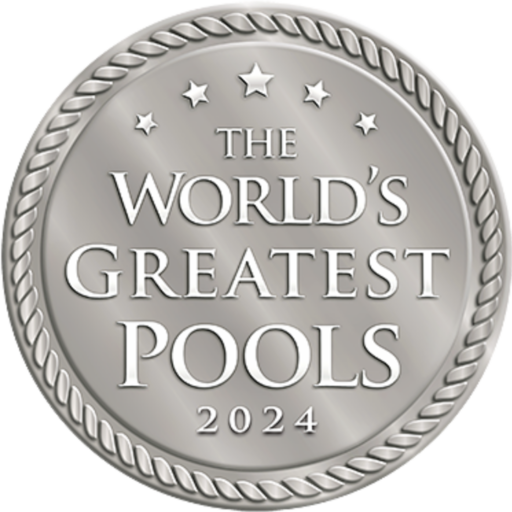An Olympic swimming pool measures 50 meters long by 25 meters wide, with a minimum depth of 2 meters. You'll find eight racing lanes, each 2.5 meters wide, with supplementary outer space requirements. The pool holds approximately 2.5 million liters (660,000 gallons) of water and must maintain temperatures between 25-28 degrees Celsius. These standardized dimensions have remained consistent since the 1924 Paris Olympics, though there's much more to these impressive aquatic facilities.
Standard Olympic Pool Dimensions

An Olympic swimming pool adheres to strict dimensional specifications set by FINA (Fédération Internationale de Natation). You'll find that these pools measure exactly 50 meters in length and 25 meters in width, creating a surface area of 1,250 square meters. The pool construction must maintain a uniform depth of at least 2 meters, with a recommended depth of 3 meters for international competitions.
The historical significance of these standardized dimensions dates back to the 1924 Paris Olympics, when FINA established consistent measurements to guarantee fair competition worldwide. Today's Olympic pools must include ten lanes, each 2.5 meters wide, with two extra spaces of 2.5 meters along the outer edges. The water temperature must be maintained between 25-28 degrees Celsius for ideal performance.
Lane Requirements and Specifications
While Olympic pool dimensions establish the thorough structure, lane requirements demand likewise precise specifications to guarantee fair competition. You'll find that each Olympic pool must have eight lanes, with a standardized lane width of 2.5 meters. Lane markings run along the pool's bottom in dark, contrasting colors, extending from end to end.
The lanes are separated by floating lane dividers made of plastic discs that help absorb waves and reduce turbulence between swimmers. Each lane must include distinctive markers at both the 15-meter and 25-meter points from each end wall. These markings help swimmers gauge their position during races, particularly during backstroke events where they need to count strokes before their turn. The outer lanes (1 and 8) require extra space of 0.2 meters on each side.
Pool Depth and Temperature Guidelines

Olympic swimming pools must maintain strict depth and temperature standards to guarantee peak performance and safety. You'll find that the minimum depth requirement is 2 meters (6.6 feet), though many facilities opt for depth variations ranging from 2 to 3 meters to accommodate different swimming events and diving requirements.
The pool temperature must stay between 25-28 degrees Celsius (77-82.4 degrees Fahrenheit), with 26 degrees Celsius (78.8 degrees Fahrenheit) being the ideal temperature for competitive swimming. This specific range helps prevent athlete fatigue while maintaining perfect conditions for world-record attempts. If you're operating an Olympic facility, you'll need sophisticated temperature control systems to maintain these precise specifications throughout the pool, ensuring consistent conditions across all lanes and depths.
Volume and Water Capacity
Standard Olympic pools hold a massive 2.5 million liters (660,000 gallons) of water when filled to competition levels. You'll find that this water volume accounts for every cubic centimeter of the pool's total capacity, from the surface down to its deepest point. The pool's capacity measurements are precisely calculated based on its standardized dimensions of 50 meters by 25 meters, with varying depths.
To put these numbers in perspective, you're looking at enough water to fill a one-acre plot of land to a depth of 2 feet. The sheer volume of water requires sophisticated filtration systems to maintain water quality and specialized drainage systems for maintenance. You'll notice that competition pools maintain strict water levels to guarantee consistent conditions for all swimmers.
Key Design Features and Safety Standards

Olympic swimming pools must maintain strict depth requirements of at least 2 meters (6.6 feet) throughout, with a minimum depth of 3 meters (9.8 feet) where starting blocks are installed. You'll notice standardized lane markings, including T-shaped black markers at each end and dark lines running the length of the pool to guide swimmers. Emergency equipment, including rescue poles, life preservers, and primary aid stations, must be strategically positioned around the pool deck according to international swimming federation (FINA) regulations.
Pool Depth Requirements
The depth requirements for competitive Olympic pools must meet strict international specifications established by FINA (Fédération Internationale de Natation). You'll find that depth variations play an essential role in different swimming events, with specific competitive standards for each section of the pool.
| Pool Section | Minimum Depth (m) | Maximum Depth (m) | Primary Use |
|---|---|---|---|
| Starting End | 2.0 | 3.0 | Diving starts |
| Middle Area | 1.8 | 2.5 | Racing length |
| Turning End | 2.0 | 3.0 | Flip turns |
| Overall Range | 1.8 | 3.0 | All events |
The deeper sections at both ends accommodate diving starts and turns, while the middle section maintains sufficient depth for effective swimming without excessive downward pressure. These specifications guarantee fair competition and peak performance across all Olympic swimming events.
Emergency Equipment and Markings
Safety regulations mandate numerous emergency and marking requirements for Olympic competition pools to guarantee athlete protection and event integrity. You'll find standardized safety signage clearly displaying pool depths, emergency exits, and warning notices at specified intervals around the perimeter.
Rescue equipment must be readily accessible, including life rings, reaching poles, and primary aid stations positioned strategically poolside. You'll notice distinctive lane markings on the pool bottom and touch panels at both ends for precise timing. The pool's edges feature standardized grip handles and non-slip surfaces for swimmer safety during entry and exit.
All markings must meet strict visibility requirements, using contrasting colors that remain clear both above and below the water's surface. These features guarantee consistent competition conditions while maintaining essential safety standards throughout Olympic events.
Comparing Olympic Pools to Other Pool Types
Standard swimming pools come in several common configurations that differ greatly from Olympic specifications. You'll find that recreational pools and competition pools vary considerably in their dimensions and features.
- Backyard pools typically range from 12 to 32 feet in length, while Olympic pools stretch to 164 feet
- High school competition pools often measure 25 yards, roughly half the Olympic length
- Hotel pools average 40-50 feet long and lack competition-grade lane markers
- Public recreational pools frequently feature irregular shapes and varying depths
- Short-course competition pools measure 25 meters, compared to Olympic's 50 meters
When comparing Olympic pools to other types, you'll notice the stark differences in depth requirements, lane width specifications, and general water volume. Olympic pools maintain strict uniformity, while other pools prioritize their specific intended uses.
Frequently Asked Questions
How Often Is the Water Completely Replaced in an Olympic Pool?
You'll find that Olympic pools don't typically require complete water replacement as part of regular pool maintenance. Instead, they use advanced filtration systems that continuously clean and recirculate the water. The water quality is maintained through daily chemical treatments and monitoring. You'll only need to completely replace the pool water if there's a major contamination issue or during extensive renovation work, which might occur every few years.
How Long Does It Take to Fill an Olympic Swimming Pool?
You'll need approximately 15-20 hours to fill an Olympic swimming pool, depending on your water pressure and the number of inlet points. The filling process typically requires multiple high-capacity pumps working simultaneously to manage the 2.5 million liter (660,000 gallon) water capacity. If you're using standard municipal water pressure through limited inlet points, this process could extend to 24 hours or longer.
Why Are Olympic Pools Sometimes Referred to as "Fast Pools"?
When you hear about "fast pools," it refers to specific pool design elements that create a competitive advantage for swimmers. These pools feature deep basins that minimize wave reflection, optimized gutter systems that absorb turbulence, and lane lines that effectively disperse water movement. You'll also find that fast pools incorporate precise temperature control and specialized surfaces that reduce drag, allowing athletes to achieve superior speeds during competition.
What Happens to Olympic Pools After the Games Are Over?
You'll find that Olympic pools often undergo pool repurposing after the Games conclude. These world-class aquatic facilities typically serve their host cities in diverse ways: they're converted into public swimming centers, university athletic complexes, or training facilities for future athletes. Some venues maintain their Olympic-standard status for hosting international competitions, while others are modified into multi-purpose recreational centers. In rare cases, they're dismantled and relocated to other communities.
How Many Olympic-Sized Swimming Pools Exist in the World?
You'll find it challenging to get an exact count of Olympic-sized pools worldwide due to varying global pool distribution data. However, experts estimate there are between 85,000 to 100,000 50-meter pools globally. The Olympic venue count represents just a small fraction of these facilities. Most of these pools are located at universities, high-performance training centers, and municipal recreation complexes across developed nations.



